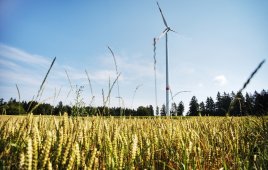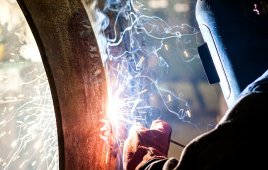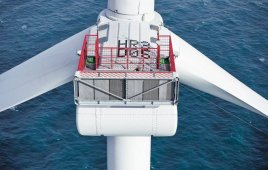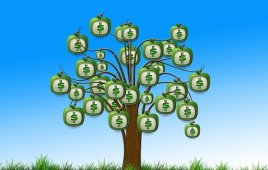Turbine manufacturer Areva Wind recently won a contract worth €400 million to supply 40, 5-MW turbines for the Borkum West II offshore wind farm in the North Sea near Germany. Under the agreement with Trianel, an association of German urban electric utilities and communities, Areva will provide the turbines, commissioning, and maintenance services. Foundations, transport, and erection offshore are excluded from the scope.
What’s more significant is this project’s financing. Previously, offshore wind farms were supported by government-sponsored export credit agencies and only financed by banks after final commissioning. “Given the newness of offshore construction, banks are reluctant to take risks because they judge that construction risks there are higher than onshore work,” says Areva Renewables’ VP Project Control & Finance Jay Boardman.
Borkum West II is stretching the prevailing boundaries for European offshore non-recourse financing. European banks now accept a number of risk features, such as non-recourse, multi-contract, and construction-phase financing, which up till now they have not.
Boardman explains how non-recourse financing works. A special-purpose company funds project assets with debt from banks and equity from shareholders. Project revenues repay the debt and reward the shareholders. If the project fails, banks have recourse only to the project company’s assets for repayment and cannot pursue the shareholders for any non-repaid debt. Non-recourse financing corresponds well to project developers’ objectives, but banks require greater security or less risk for giving-up recourse to shareholders. In total, 11 banks financed about 500 M€ of debt.
The U.S. market will likely develop in a similar way by starting with a couple of smaller projects in state waters, such as Block Island and a 20-MW project in New Jersey. “With the experience we’ve gained overseas, we would like to bypass in the U.S. a lot of the small-project ramping up that Europe has gone through,” says Cuevas, “and jumpstart by building an offshore wind industry representing thousands of megawatts.”
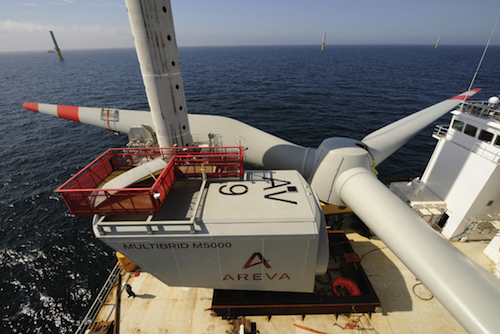
Monopiles await their turbines in the Alpha Ventus farm. Borkum West II, one of the largest wind-energy projects in the German North Sea, is adjacent to Alpha Ventus, Germany’s pilot offshore wind farm to which Areva supplied six 5-MW wind turbines. Operations are scheduled to start before 2013. Once completed, the turbines will be capable of a total output of 200 MW.
Areva Renewables’ Director Offshore Wind Business Development Steven Cuevas adds, “That’s is why the first financing of Areva’s turbines makes a good story. This project has risk characteristics banks were willing to finance on their own, without the backup of the sponsor’s balance sheet. These are the most important aspects to the project’s financeability. Project company assets are the only thing at risk.”
Areva had European Investment Bank (EIB) support to decrease commercial bank lending. However Boardman says there was no import-export bank support to bear part of the project risk, which has been the typical European way to sell wind turbines produced in Germany for other European markets.
Since the financial crisis, banks are extremely risk adverse. The European Investment Bank has acted as a secure foundation to attract and build critical mass among commercial banks for these types of projects. Once the EIB signs onto a project, it brings a good portion of financing that helps other commercial banks get behind the project. “As the economy improves, and we show wind technology maturing with merit, banks are coming back in and willing to take a bit more risk,” says Boardman. “This is why Borkum West II is an exceptional project. It stands as the new reference for non-recourse financing.”
Capital markets are warming up, adds Boardman. “There are awesome funding needs for equity and debt. Conditions are coming together to bring commercial banks into offshore wind projects. This is another shift, European banks becoming less risk adverse because projects are showing merit. Alpha Ventus and other pilot projects have provided feedback to make banks comfortable.”
In the past, European banks usually waited until a project’s construction phase finished before stepping in with financing. “That takes one major risk element out,” says Boardman. “Banks often say, ‘If you want financing for a construction phase, start with a six-turbine installation before expanding it with 40 more.’” This staged approach was critical in getting financing needed from Day One, and keeping the non-recourse structure to ensure the project moves forward.
Offshore wind projects typically get rolling when there are at least two to four banks acting as Managing Lead Arrangers by assigning different responsibilities: financial analysis, technical due diligence, syndication, and documentation. Because they are growing to understand non-recourse financing, European banks are more willing to support offshore wind power.
A drawback is that the U.S. does not yet have an offshore wind industrial base. Cuevas says a key part of the offshore wind industry’s business model is job creation. “For example, assembling the 3,500 parts for our turbines and blades is estimated to generate 650 direct jobs (and 1,000s of indirect jobs in the supply chain) with an additional 500 service jobs during project operations,” he says. But this is an expensive industry to establish. “To build an offshore wind industrial base in the U.S., he says, we need to see a long-horizon market for more work. That is, the EPCs, suppliers, vessel builders, and operators unique to an offshore wind industry want to see an initial five-year horizon on projects to justify mobilizing the industry. Hopefully, by studying and validating what has happened overseas, we can take those lessons quickly to scale in the U.S,” he adds.
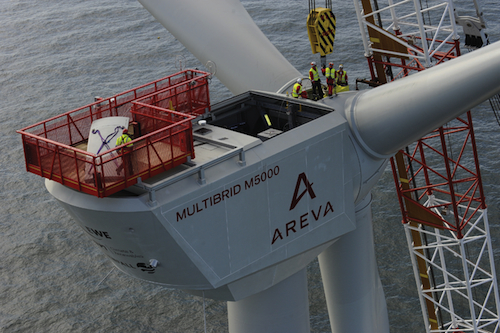
About 40 of Areva’s 5 MW offshore turbine will power the Borkum West II wind farm. It will be built in about 38 ft of water and about 30 mi from Germany’s Northern coast. BWII is the first German North Sea wind farm financed on a non-recourse basis from the construction phase.
In terms of financing, Areva executives say large projects are the only way to justify building an industrial supply chain and making the large investments necessary to create a domestic industry.
Expect to see European banks involved in U.S. projects. “Many U.S. developers already have relationships with financiers and banks in Europe,” says Cuevas. “Those banks are more familiar with offshore wind-project risk profiles and technology, as well as warranties and guarantees that make a project successful. “So at an initial stage, lead banks may come from Europe and perhaps syndicate with some U.S. banks until the domestic firms are comfortable with the market. U.S. banks are still generally risk adverse, so it’s likely to see more experienced banks from Europe investing in the U.S.”
European pilot projects have acted as proving grounds, not just for the technology, but also for foundations, logistics, and project management. Banks have no boundaries, so they would be able to step in and use their financing skills and risk experience to put these U.S. projects together. “The good news is that offshore capacity factors have shown consistently better than what were expected,” says Boardman. “There will be a ramp up for the U.S., but it will be shorter than Europe’s.”
WPE
Filed Under: Financing

